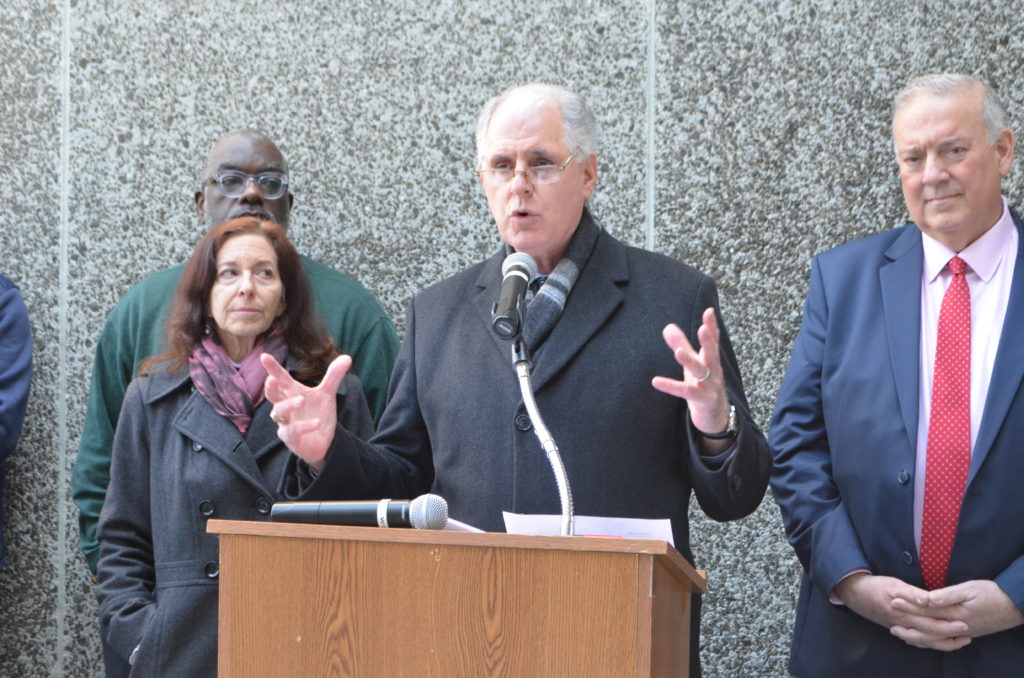Councilmember Jim Gennaro was joined by local union representatives and climate activists to make a last-minute push for the approval of two statewide clean energy investments.
The New York State Public Service Commission is slated to decide the fate of both the Champlain Hudson Power Express and Clean Path New York later this week.
With the state of New York on its way to achieving the mandated goal of zero-emission electricity by 2040, including a 70 percent renewable energy generation by 2030, the combined projects of Clean Path NY and CHPE would reduce greenhouse gas emissions by 77 million metric tons over the next 15 years.
“I urge the New York State Public Service Commission to approve both of these projects,” Gennaro said at the members of Local 3 IBEW. “By investing in clean energy, creating new green jobs in our communities, and reducing our reliance on fossil fuels, these projects represent a crucial step towards meeting New York’s energy goals.”
Combined, the two projects in the pipeline also have the potential to bring 2,500 megawatts of clean power into the community, which could lead to the closure of peaker plants in Astoria.
The hydropower CHPE project would see a buried transmission line run 339 miles from the U.S.-Canadian border, south through Lake Champlain, along and underneath the Hudson River, before ending at a converter station in Astoria.
Adrienne Esposito, the executive director of The Citizens Campaign for the Environment, spoke in favor of the project and the renewable energy it would bring to New York. She responded to questions concerning environmental concerns with the project, saying that the benefits outweigh the negatives.
“It will have minimal impact for the maximum benefit,” Esposito said. “All large-scale energy infrastructure has some impact on the environment. But we have a moral and ethical obligation to choose energy infrastructure with the least impact to our environment.”
Both projects are part of the newly-created Tier 4 program, which aims to reduce reliance on fossil fuel energy.
Local 3 IBEW Business Manager Chris Erikson Jr. said that marginalized communities across New York have been bearing the brunt of pollution. He added that he is committed to giving union workers opportunities for “green jobs,” which could see workers go through the union’s apprenticeship program and become full-time electricians.
“I think the worst thing that can happen to me is that my granddaughter is going to look back and say, if things are still messed up, why didn’t grandpa fix it up and he had a chance? So, I am a climate warrior, along with many that stand here with us today,” Erikson Jr. said.
“Certainly, a transition out of fossil fuels has to happen,” he continued. “The tier four projects are key to making that happen. It wasn’t easy to agree to plug your extension cord into Canada. I’ve come to grips with it, and we really need to get it done.”
Queens Chamber of Commerce President and CEO Tom Grech said that there is no better time than now to approve the two tier four projects for the state. The Chamber’s “Queens is Green” initiative, he says, aims to make Queens County the greenest of the 62 in the state.
“At the end of the day, this product seems to be a no-brainer,” Grech said. “We hope to have a very good outcome from this project.”
If approved, the projects are expected to start delivering power to New York City in 2025 for the CHPE project, and 2027 for the CPNY project.



